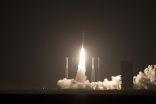(Press-News.org) Following a successful launch at 10:44 p.m. EDT Thursday, NASA's four Magnetospheric Multiscale (MMS) spacecraft are positioned in Earth's orbit to begin the first space mission dedicated to the study of a phenomenon called magnetic reconnection. This process is thought to be the catalyst for some of the most powerful explosions in our solar system.
The spacecraft, positioned one on top of the other on a United Launch Alliance Atlas V 421 rocket, launched from Cape Canaveral Air Force Station, Florida. After reaching orbit, each spacecraft deployed from the rocket's upper stage sequentially, in five-minute increments, beginning at 12:16 a.m. Friday, with the last separation occurring at 12:31 a.m. NASA scientists and engineers were able to confirm the health of all separated spacecraft at 12:40 a.m.
"I am speaking for the entire MMS team when I say we're thrilled to see all four of our spacecraft have deployed and data indicates we have a healthy fleet," said Craig Tooley, project manager at NASA's Goddard Space Flight Center in Greenbelt, Maryland.
Over the next several weeks, NASA scientists and engineers will deploy booms and antennas on the spacecraft, and test all instruments. The observatories will later be placed into a pyramid formation in preparation for science observations, which are expected to begin in early September.
"After a decade of planning and engineering, the science team is ready to go to work," said Jim Burch, principal investigator for the MMS instrument suite science team at the Southwest Research Institute in San Antonio (SwRI). "We've never had this type of opportunity to study this fundamental process in such detail."
The mission will provide the first three-dimensional views of reconnection occurring in Earth's protective magnetic space environment, the magnetosphere. Magnetic reconnection occurs when magnetic fields connect, disconnect, and reconfigure explosively, releasing bursts of energy that can reach the order of billions of megatons of trinitrotoluene (commonly known as TNT). These explosions can send particles surging through space near the speed of light.
Scientists expect the mission will not only help them better understand magnetic reconnection, but also will provide insight into these powerful events, which can disrupt modern technological systems such as communications networks, GPS navigation, and electrical power grids.
By studying reconnection in this local, natural laboratory, scientists can understand the process elsewhere, such as in the atmosphere of the sun and other stars, in the vicinity of black holes and neutron stars, and at the boundary between our solar system's heliosphere and interstellar space.
The spacecraft will fly in a tight formation through regions of reconnection activity. Using sensors designed to measure the space environment at rates100 times faster than any previous mission.
"MMS is a crucial next step in advancing the science of magnetic reconnection - and no mission has ever observed this fundamental process with such detail," said Jeff Newmark, interim director for NASA's Heliophysics Division at the agency's Headquarters in Washington. "The depth and detail of our knowledge is going to grow by leaps and bounds, in ways that no one can yet predict."
MMS is the fourth mission in the NASA Solar Terrestrial Probes Program. Goddard built, integrated and tested the four MMS spacecraft and is responsible for overall mission management and operations. The principal investigator for the MMS instrument suite science team is based at the SwRI. Science operations planning and instrument commanding are performed at the MMS Science Operations Center at the University of Colorado Boulder's Laboratory for Atmospheric and Space Physics.
INFORMATION:
More information about the MMS mission is available at:
http://www.nasa.gov/mms
Tropical Cyclone Nathan has made its cyclonic loop in the Coral Sea near Queensland, Australia's Cape York Peninsula, and is headed away from land. However, satellite imagery reveals that Nathan's movement away from Queensland is a slow crawl.
On March 13 at 1500 UTC (11 a.m. EDT), Tropical Cyclone Nathan's maximum sustained winds were near 55 knots (63 mph/102 kph). It was centered near 13.1 south latitude and 145.5 east longitude, about 229 nautical miles (263 miles/424 kph) north of Cairns, Australia. Nathan has slowed down and was moving to the east-northeast at 2 ...
Tiny populations of invasive species such as Asian carp start their domination of new ecosystems by hanging out at local landmarks, according to a new study published in the journal Theoretical Ecology this week.
Understanding how species use these local hotspots can play a key role in how officials approach population control for conserving endangered species and controlling invasive ones.
"We recently found that only ten Asian carp are needed to establish a population in the Great Lakes," said Kim Cuddington, an ecology professor from the University of Waterloo. "But ...
(Seattle, WA - March 12, 2015) Scientists at Benaroya Research Institute at Virginia Mason (BRI) have made an unexpected discovery that overturns a longstanding belief in the biological sciences. Research, led by Chris Amemiya, PhD, a member at BRI, and primarily conducted by Joyce Tang, was published online in today's issue of Current Biology. The research demonstrates that chitin, a molecule that was previously thought to be absent in vertebrates and that has been shown to trigger an allergy/immune reaction in mammals, is endogenously produced in fishes and amphibians. ...
NASA's Aqua satellite passed over Tropical Storm Bavi as it continued on a west-northwesterly track through the Northwestern Pacific Ocean. Bavi has already generated a typhoon watch for Guam, Rota, Tinian and Saipan.
The Atmospheric Infrared Sounder or AIRS instrument aboard NASA's Aqua satellite captured an image of Bavi on March 13. The image showed the eastern two-thirds of the storm and revealed strong thunderstorms around the center of circulation and a thick band of thunderstorms north of the center.
On March 13 at 1500 UTC (11 a.m. EDT), Tropical Storm Bavi ...
ST. LOUIS -- A flu vaccine given just under the surface of the skin that includes four strains of inactivated influenza could be more protective than a similar flu vaccine containing only three strains, Saint Louis University research found.
These findings, which appear in Vaccine, confirmed the expected results, said Geoffrey Gorse, M.D., professor of internal medicine in the division of infectious diseases at Saint Louis University and the study's lead author.
Findings from this study of flu vaccines delivered by a small needle intradermally parallel earlier results ...
PASADENA, Calif., March 13, 2015 -- Expanding blood pressure screenings to non-primary care settings can help identify more patients with high blood pressure, commonly called hypertension, and could contribute to better hypertension control and management, according to a Kaiser Permanente study published today in The Journal of Clinical Hypertension.
Researchers examined the electronic health records of 1,076,000 Kaiser Permanente Southern California patients seen over a two-year period in primary care settings and non-primary care settings, including optometry, orthopedics, ...
Preventable deaths caused by acute kidney injury (AKI) could be nearly eliminated in just 10 years, according to leading medical experts. This often forgotten condition - which affects around 13 million people every year and contributes to 1.7 million deaths annually - is preventable and can be treated for as little as $US150 per patient.
A major new Commission from The Lancet and the International Society of Nephrology (ISN) reports on an ISN initiative, launched in 2013, which calls for preventable deaths from AKI to be eliminated by 2025 (0by25). According to Professor ...
New estimates published in The Lancet indicate that at best only half of people worldwide needing kidney dialysis or transplantation to treat kidney failure in 2010 received it. This suggests that at least 2.3 million people may have died prematurely from kidney failure because they could not access this life-saving treatment.
The research shows that most of these preventable deaths occurred in China, India, Indonesia, Pakistan, and Nigeria, where less than a quarter of eligible patients receive treatment for kidney failure.
"The high cost of current dialysis techniques ...
SAN DIEGO -- Healthy young adults who don't consume caffeine regularly experienced greater rise in resting blood pressure after consumption of a commercially available energy drink -- compared to a placebo drink -- thus raising the concern that energy drinks may increase the risk of cardiac events, Mayo Clinic researchers found.
Results of the study will be presented Saturday, March 14, at the American College of Cardiology's 64th Annual Scientific Session in San Diego.
In this study, researchers alternately gave a can of a commercially available energy drink or a placebo ...
SAN DIEGO -- People exposed to prolonged periods of shortened sleep have significant increases in blood pressure during nighttime hours, Mayo Clinic researchers report in a small study of eight participants.
Results of the study will be presented Sunday, March 15, at the American College of Cardiology's 64th Annual Scientific Session in San Diego.
In this study, eight healthy, normal weight participants, ages 19 to 36, participated in a 16-day inpatient protocol, consisting of a four-day acclimation period followed by nine days of either sleep restriction (four hours ...



